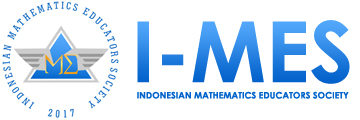The Application of Cryptography in Mathematics Education: A Study on Modulo
Abstract
Cryptography has significant potential to enrich mathematics education. Besides its direct relation to mathematics, cryptography can also be used as a novel method for teaching mathematics at the school level. The cryptographic method offers a fresh perspective on mathematics lessons and can change students' views of mathematics more positively. The Caesar Cipher cryptography is one of the most straightforward and well-known cryptographic techniques for encrypting and decrypting text. This research aims to implement cryptography in mathematics learning based on Realistic Mathematics Education (RME) for the modulo material. The type of research used is library research. The research data were collected from several books on cryptography and several journals on cryptography and mathematics education. The results of this study indicate the implementation of mathematics learning in the form of modulo concepts in Caesar ciphers at the Sandi Museum in Yogyakarta. These mathematical concepts can be utilized to introduce and understand interesting and realistic mathematical concepts.
Keywords
Full Text:
PDFReferences
Abdullah, N., Zakaria, E., & Halim, L. (2012). The effect of a thinking strategy approach through visual representation on achievement and conceptual understanding in solving mathematical word problems. Asian Social Science, 8(16), 30. https://doi.org/10.5539/ASS.V8N16P30.
Alisherovich, Y. J. (2023). The importance of mathematics in the prosperity of society. American Journal of Applied Science and Technology, 3(10), 20-24.
Ardiansah, D., Yusmianti, M., & Firdaus, A. R. (2019). Mathematical learning motivation of submission and reduction of participants in primary school using Realistic Mathematics Education (RME). PrimaryEdu: Journal of Primary Education, 3(1), 27-34. https://doi.org/10.22460/PEJ.V3I1.1223.
Bryant, L. (2006). Caesar Ciphers: An Introduction to Cryptography.
Budaghyan, L., Li, C., & Parker, M. G. (2019). Special issue on mathematical methods for cryptography. Cryptography and Communications, 11, 363-365. https://doi.org/10.1007/s12095-019-00356-8.
Caraan, D. R., Dinglasan, J. K., & Ching, D. (2023). Effectiveness of realistic mathematics education approach on problem-solving skills of students. International Journal of Educational Management and Development Studies, 4(2), 64-87. https://doi.org/10.53378/352980.
Dafid, D. (2006). Symmetric Key Cryptography Using the Crypton Algorithm. goritma, 2(3), 20-27.
Durand-Guerrier, V. (2003). Which notion of implication is the right one? From logical considerations to a didactic perspective. Educational Studies in mathematics, 53, 5-34.
Erman, S. (2003). Contemporary Strategies for Mathematics Education. Bandung: Universitas Pendidikan Indonesia.
Fitri, A., Pakpahan, H., & Matondang, N. (2023). The Effect of RME application on mathematics learning outcomes. International Journal of Educational and Psychological Sciences, 1(23), 313-320. https://doi.org/10.59890/ijeps.v1i4.916.
Gee, E., Fauzan, A., & Atmazaki, A. (2018). Designing learning trajectory for teaching sequence and series using RME approach to improve students’ problem solving abilities. In Journal of Physics: Conference Series, 1088(1), 012096. IOP Publishing. https://doi.org/10.1088/1742-6596/1088/1/012096.
Geiges, H. (2000). Facets of the cultural history of mathematics. European Review, 8(4), 487-497. https://doi.org/10.1017/S1062798700005044.
Ginting, D. B. (2010). The Role of Modular Arithmetic and Prime Numbers in the RSA Cryptographic Algorithm. Media inform. sekol. tinggi manaj. inform. dan Komput. LIKMI, 9(2), 48-57.
Gravemeijer, K. P. E. (1994). Developing realistic mathematics education.
Gravemeijer, K., & Doorman, M. (1999). Context problems in realistic mathematics education: A calculus course as an example. Educational studies in mathematics, 39(1), 111-129. https://doi.org/10.1023/A:1003749919816.
Hang, N., Quyet, V., & Thanh, L. (2021). Designing realistic mathematics problems for the last grade of secondary school. Vinh University Journal of Science. 50(1), 36-45 https://doi.org/10.56824/vujs.2021ed15.
Howson, A. G. (1974). Mathematical thought from ancient to modern times, by Morris Kline. Pp xvii, 1238. 12. 1973 (Oxford University Press). The Mathematical Gazette, 58(403), 58-59. https://doi.org/10.2307/3615488.
Laurens, T., Batlolona, F. A., Batlolona, J. R., & Leasa, M. (2017). How does realistic mathematics education (RME) improve students’ mathematics cognitive achievement?. Eurasia Journal of Mathematics, Science and Technology Education, 14(2), 569-578. https://doi.org/10.12973/EJMSTE/76959.
Loc, N. P., & Tien, N. T. T. (2020). Approach to realistic mathematics education in teaching mathematics: A case of cosine theorem–Geometry 10. International Journal of Scientific and Technology Research, 9(4), 1173-1178.
Mirzaqon, A., & Purwoko, B. (2018). Literature Review on the Theoretical Foundations and Practice of Expressive Writing Counseling. Jurnal BK Unesa, 1, 1-8.
Mubarok, N. (2019). Implementation of the modified enigma cryptographic algorithm as a PMRI-based mathematics learning medium for function composition and inverse function materials. Journal of Mathematics Education, 7(1), 65-80.
Muhtarom, M., Nizaruddin, N., Nursyahidah, F., & Happy, N. (2019). The effectiveness of realistic mathematics education to improve students'multi-representation ability. Infinity Journal, 8(1), 21-30. https://doi.org/10.22460/INFINITY.V8I1.P21-30.
Nasution, A. B. (2019). Implementation of Data Security Using the Caesar Cipher Algorithm and Transposition Cipher. (JurTI) Jurnal Teknologi Informasi, 3(1), 1-6.
Negara, H. R. P., Ibrahim, M., Kurniawati, K. R. A., Firdaus, A., Maulidina, R., & Saifudin, M. (2021). The effect of the realistic mathematic education (rme) learning model on students’ mathematical problem solving abilities: A Meta-Analysis. Justek: Jurnal Sains Dan Teknologi, 4(1), 40-51.
Nisak, K. (2015). Cryptographic Encoding Methods Using Hill Cipher and Caesar Cipher with AppInventor (Doctoral dissertation, Universitas Islam Negeri Maulana Malik Ibrahim). http://etheses.uin-malang.ac.id/id/eprint/6275
Octaria, D., Zulkardi, Z., & Putri, R. I. I. (2023). Systematic Literature Review: How students learn linear programming with realistic mathematics education?. International Journal of Trends in Mathematics Education Research, 6(1), 41-46. https://doi.org/10.33122/ijtmer.v6i1.174.
Paar, C., & Pelzl, J. (2010). Understanding cryptography (Vol. 1). Springer-Verlag Berlin Heidelberg.
Prahmana, R. C. I., Sagita, L., Hidayat, W., & Utami, N. W. (2020). Two decades of realistic mathematics education research in Indonesia: A survey. Infinity Journal, 9(2), 223-246. https://doi.org/10.22460/infinity.v9i2.p223-246
Priest, G. (2023). Logic as applied mathematics–with particular application to the notion of logical form. Logic and Logical Philosophy, 32(3), 443-457. https://doi.org/10.12775/llp.2023.003.
Rosyada, M. N., & Retnawati, H. (2021). Challenges of mathematics learning with heuristic strategies. Al-Jabar: Jurnal Pendidikan Matematika, 12(1), 161-173. https://doi.org/10.24042/AJPM.V12I1.8730.
Schneier, B. (1996). Applied Cryptography: protocols, algorithms, and source code in c. Canada: John Wiley & Sons, Inc.
Schneier, B. (2007). Applied cryptography: protocols, algorithms, and source code in C.
Schoenfeld, A. H. (2016). Learning to think mathematically: Problem solving, metacognition, and sense making in mathematics (Reprint). Journal of education, 196(2), 1-38. https://doi.org/10.1177/002205741619600202.
Silverman, J. H., Pipher, J., & Hoffstein, J. (2008). An introduction to mathematical cryptography (Vol. 1). Springer New York. https://doi.org/10.5860/choice.46-3906.
Sinaga, B., Sitorus, J., & Situmeang, T. (2023). The influence of students’ problem-solving understanding and results of students’ mathematics learning. In Frontiers in Education 8,1088556. Frontiers Media SA. https://doi.org/10.3389/feduc.2023.1088556.
Sitorus, J. (2016). Students’ creative thinking process stages: Implementation of realistic mathematics education. Thinking Skills and Creativity, 22, 111-120. https://doi.org/10.1016/J.TSC.2016.09.007.
Stephan, M. L., Chval, K. B., Wanko, J. J., Civil, M., Fish, M. C., Herbel-Eisenmann, B., ... & Wilkerson, T. L. (2015). Grand challenges and opportunities in mathematics education research. Journal for research in mathematics education, 46(2), 134-146. https://doi.org/10.5951/JRESEMATHEDUC.46.2.0134.
Sumirattana, S., Makanong, A., & Thipkong, S. (2017). Using realistic mathematics education and the DAPIC problem-solving process to enhance secondary school students' mathematical literacy. Kasetsart Journal of Social Sciences, 38(3), 307-315. https://doi.org/10.1016/J.KJSS.2016.06.001.
Suryanti, S., Nusantara, T., Parta, I. N., & Irawati, S. (2023). Problem-Based Tasks in Mathematics Learning: Opportunities and Challenges for Teachers. JTAM (Jurnal Teori dan Aplikasi Matematika), 7(2), 372-383. https://doi.org/10.31764/jtam.v7i2.12864.
Treffers, A. (1993). Wiskobas and Freudenthal realistic mathematics education. Educational Studies in Mathematics, 25(1), 89-108. https://doi.org/10.1007/978-94-017-3377-9_6.
Webb, D. C., Van der Kooij, H., & Geist, M. R. (2011). Design research in the Netherlands: Introducing logarithms using realistic mathematics education. Journal of Mathematics Education at Teachers College, 2(1) 47-52. https://doi.org/10.7916/JMETC.V2I1.708.
Widodo, S., Santia, I., Katminingsih, Y., & Handayani, A. D. (2023). Increasing Students' Mathematical Problem Solving Ability Through Realistic Mathematics Education (RME). International Journal of Research and Review, 10(1), 68-76. https://doi.org/10.52403/ijrr.20230109.
Refbacks
- There are currently no refbacks.

This work is licensed under a Creative Commons Attribution-NonCommercial-ShareAlike 4.0 International License.
Indonesian Journal of Ethnomathematics
Indonesian Mathematics Educators Society
Jl. Terusan Jend. Sudirman, Kec. Cimahi Tengah, Kota Cimahi, Jawa Barat 40521
E-mail: [email protected]
ISSN: 2775-8001


